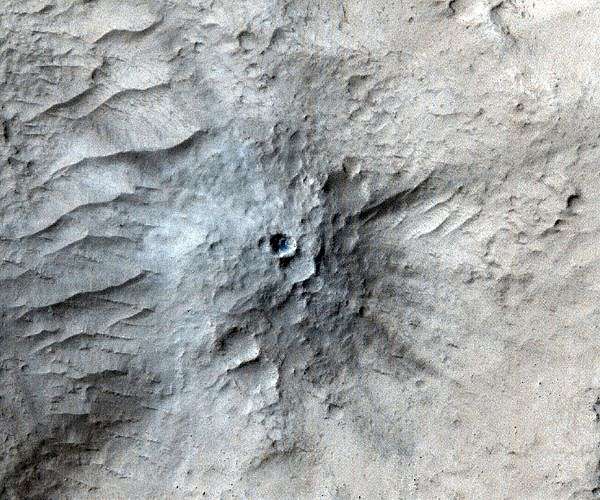New Martian Crater Reveals Far-Reaching Seismic Signals
by Clarence Oxford
Los Angeles CA (SPX) Feb 04, 2025
By leveraging artificial intelligence, researchers have identified a newly formed crater on Mars, revealing that the impact event propelled vibrations deep into the planet’s mantle.
Recent findings show that meteoroid impacts on Mars generate seismic waves that penetrate farther into the planet’s interior than once believed. Two new studies illustrate this by matching quake data from NASA’s InSight lander with impact structures documented by the Mars Reconnaissance Orbiter (MRO).
Appearing in Geophysical Research Letters (GRL) on Monday, Feb. 3, both studies underline how data from InSight remains invaluable even after NASA ended the mission in 2022 following an extended period of operation. InSight deployed the first seismometer on Mars, capturing over 1,300 marsquakes triggered by subsurface rock fracturing and by meteoroids colliding with the surface.
Examining the transformation of seismic waves traveling through the Martian crust, mantle, and core allows researchers to peer into Mars’ internal structure. This approach also enhances knowledge of the formation processes common to rocky planets, such as Earth and our Moon.
Previously, scientists have photographed newly formed craters and tied them to seismic signals recorded around the same time and place. However, these latest investigations mark the first instance of linking a recent impact with tremors in Cerberus Fossae, a seismically active zone located 1,019 miles (1,640 kilometers) from InSight.
Measuring about 71 feet (21.5 meters) across, the newly identified crater is located farther from InSight than anticipated, given the intensity of the quake’s seismic readings. Because the Martian crust is believed to reduce the strength of impact-induced seismic waves, scientists concluded that the disturbance must have traveled along a more direct pathway through the mantle.
This discovery compels InSight scientists to revisit their assumptions about Mars’ internal makeup, seeking to explain why seismic vibrations from such impacts penetrate so profoundly.
“We used to think the energy detected from the vast majority of seismic events was stuck traveling within the Martian crust,” said InSight team member Constantinos Charalambous of Imperial College London. “This finding shows a deeper, faster path – call it a seismic highway – through the mantle, allowing quakes to reach more distant regions of the planet.”
Spotting Mars Craters With MRO
A newly developed machine learning algorithm at NASA’s Jet Propulsion Laboratory in Southern California was pivotal in revealing the Cerberus Fossae crater. Within just hours, this AI system can analyze tens of thousands of MRO Context Camera images, identifying crater blast zones. The algorithm then flags promising sites for experts who determine which of these areas require closer examination via MRO’s High-Resolution Imaging Science Experiment (HiRISE) camera.
“Done manually, this would be years of work,” said InSight team member Valentin Bickel of the University of Bern in Switzerland. “Using this tool, we went from tens of thousands of images to just a handful in a matter of days. It’s not quite as good as a human, but it’s super fast.”
Bickel’s team searched an area up to about 1,864 miles (3,000 kilometers) from the lander, anticipating new craters that may have formed while InSight’s instruments were active. By examining Context Camera snapshots from different periods, they identified 123 recently created craters and compared them to the lander’s seismic records, finding 49 that might correspond to recorded quakes. Charalambous and other seismologists then narrowed the list to the 71-foot Cerberus Fossae impact feature.
Deciphering More, Faster
As researchers continue to scrutinize InSight’s observations, they gain sharper skills in differentiating seismic activity generated within the planet from that resulting from meteoroid collisions. The Cerberus Fossae impact discovery will advance their methods of distinguishing these signals.
“We thought Cerberus Fossae produced lots of high-frequency seismic signals associated with internally generated quakes, but this suggests some of the activity does not originate there and could actually be from impacts instead,” Charalambous said.
Additionally, these results showcase how AI-driven approaches are revolutionizing planetary research by maximizing the immense amounts of data collected by NASA and ESA (European Space Agency) probes. Beyond crater hunting, Bickel has employed AI to detect landslides, dust devils, and the seasonal dark streaks that show up on steep inclines. Similar automated tools have already helped map craters and landslides on Earth’s Moon, too.
“Now we have so many images from the Moon and Mars that the struggle is to process and analyze the data,” Bickel said. “We’ve finally arrived in the big data era of planetary science.”
Insight
Research Report:New Impacts on Mars: Unraveling Seismic Propagation Paths Through a Cerberus Fossae Impact Detection
Related Links
MRO
Mars News and Information at MarsDaily.com
Lunar Dreams and more

